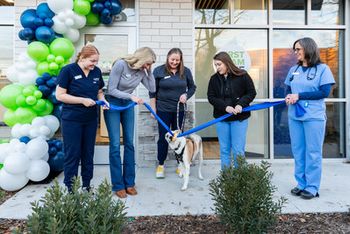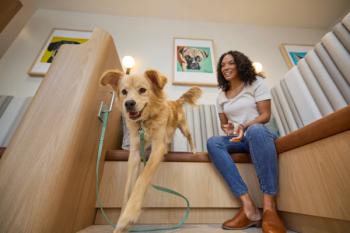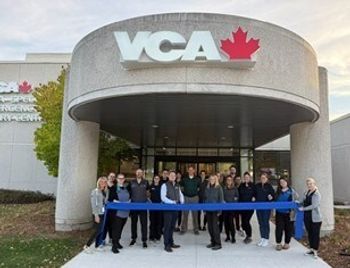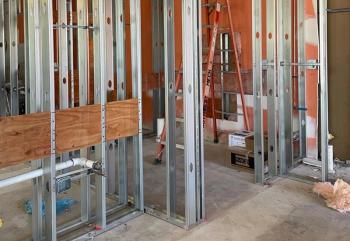
Divide and conquer
There's strength in numbers, the saying goes. But for the veterinarians at Findlay Animal Hospital in Findlay, Ohio, strength comes not only from the number of doctors but also from the number of hospitals they own around town.
By Carolyn Chapman, special assignments editor
There's strength in numbers, the saying goes. But for the veterinarians at Findlay Animal Hospital in Findlay, Ohio, strength comes not only from the number of doctors but also from the number of hospitals they own around town.
When Dr. C.R. Beckett founded Findlay Animal Clinic in 1964 and built a new veterinary facility in the early 1970s, he had no idea how his practice would grow--and that he'd build a couple more times. Despite several renovations, the 5,000-square-foot facility soon became too small.
About this time, Drs. David L. Calland and Jeffrey L. Rhoad joined Dr. Beckett as associates, and in 1986 they built Findlay Animal Care Center, a 10,000-square-foot boarding and grooming facility across town. Dr. Rhoad uses this facility to treat boarding and grooming patients, offer outpatient services, and sell retail items. The group owns another hospital just outside of town in Fostoria, and Dr. Beckett manages three other facilities they own in Columbus, Ohio.
Dr. Calland, a 1979 graduate of The Ohio State University, stayed in the old facility, where his client base continued to grow--while space got even tighter. He knew something had to change. "The inefficiencies multiplied and team members kept bumping into each other," Dr. Calland says.
That's when he spotted Northwood Animal Hospital in Anderson, Ind., a 1997 Merit Award winner. The wheels started turning in his mind--and soon he and his partners were building the 7,837-square-foot hospital that won Veterinary Economics' 2000 Hospital Design Competition Merit Award. Judges chose the hospital for its airy reception area, efficient treatment islands, doctors' station, and classic exterior design.
Expanding perfection
Dr. Calland knew finding land wasn't a problem. In a moment of foresight, Dr. Beckett had purchased a one-acre lot adjacent to the old building for future use. Traffic counts jumped from 10,000 in 1990 to more than 19,000 when the city widened the frontage road.
So Dr. Calland called and arranged a tour with veterinary architect William Copich, principal of Copich & Associates in Youngstown, Ohio, and designer of Northwood Animal Hospital. Then Dr. Calland immediately hired Copich, who assigned his daughter, architect Helen Durflinger, to design the perfect hospital.
To pick the best floor plan, Dr. Calland scoured issues of Veterinary Economics and reviewed AAHA building guidelines. He also asked staff members which features would improve their work areas. And although he was the only veterinarian planning to practice in the new facility, he consulted his partners during each design phase.
Dr. Calland deliberately omitted ancillary services. "Our other facility met that need, and we didn't want to compete with ourselves," he explains. Instead, the partners wanted the new facility to focus on medical and surgical services and handle emergencies for the three Findlay locations. Surgical referrals now come from up to 50 miles away.
Though he thought he'd found the perfect site, Dr. Calland did face a few challenges before getting started. With city streets and access roads on three sides, the site faced severe constrictions on the available building area. The city also demanded he remove two of the three curb cuts and add a new one, which meant moving a water line and meter--at Dr. Calland's expense. They also had to place engineered fill in an area occupied by a former business.
Six months after Dr. Calland's first meeting with Durflinger, construction began--and he continued practicing full-time while managing the building project. Working so close to the site had its advantages. Dr. Calland could answer workers' questions immediately. And he hired a local construction company new to veterinary hospital design, so daily walkthroughs proved valuable. "I was able to catch a few minor problems with computer outlets and oxygen lines," Dr. Calland says.
A classic look
Going for the classic look, the owners chose a red brick exterior with a wood composite for the second floor. In the reception area and exam rooms, they used suspended seating and tables secured with welded steel angles to make cleanup easy and prevent tangled leashes.
Open hallways aid traffic flow, and a doctors' station behind the exam rooms lets veterinarians make callbacks and update patient records. "Looking back, we were pretty disorganized," admits Dr. Calland. "The new hospital improves the way we practice medicine. Long-time clients didn't mind the old hospital, but our image didn't communicate the quality of medicine we offered."
Dr. Calland also paid attention to the working areas. Angled glass walls in the surgery suite allow viewing from the treatment area and the exam corridor. "We were tired of small square rooms, so we incorporated unique angles and open spaces," Dr. Calland says. Automatic door closures, an infrared sensor on the scrub sink, a standby generator, and a recirculating pump that provides hot water make practice easier.
Upstairs, an apartment lets an intern provide 24-hour monitoring. And veterinarians use the conference room for community outreach by hosting outside meetings and lectures.
A short list
More storage space for shipping receivables tops Dr. Calland's list of things he'd change. He also wishes he'd installed a double swinging door between the treatment area and the kennel. And he says the vinyl tile in the working areas is durable and easy-to-repair but requires constant cleaning.
Dr. Calland credits his success--and his short list of changes--to hiring a veterinary architect and asking staff members for input. "Hiring the experts was well worth the expense," he says. Although the project exceeded original budget estimates, he's happy with the new building and can overlook those budget overruns.
The professional image his hospital projects draws high-quality clients. And Dr. Calland reports hiring two associates since opening and fielding rsums from graduates who want to work with him. "We're the place where people want to bring their pets," he says.
Carolyn Chapman, a former Veterinary Economics associate editor, is a freelance writer in Liberty, Mo.
October 2000 Veterinary Economics
Newsletter
From exam room tips to practice management insights, get trusted veterinary news delivered straight to your inbox—subscribe to dvm360.




